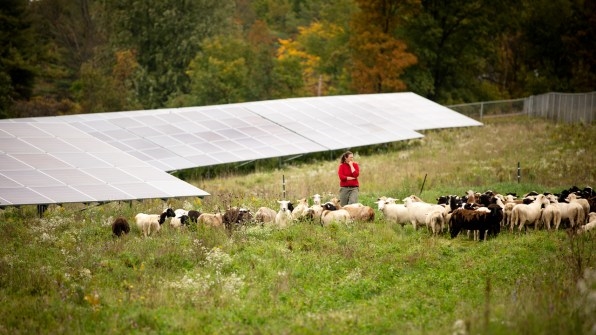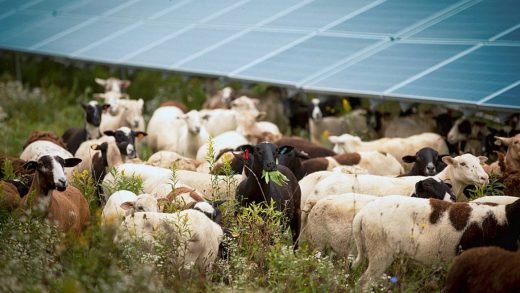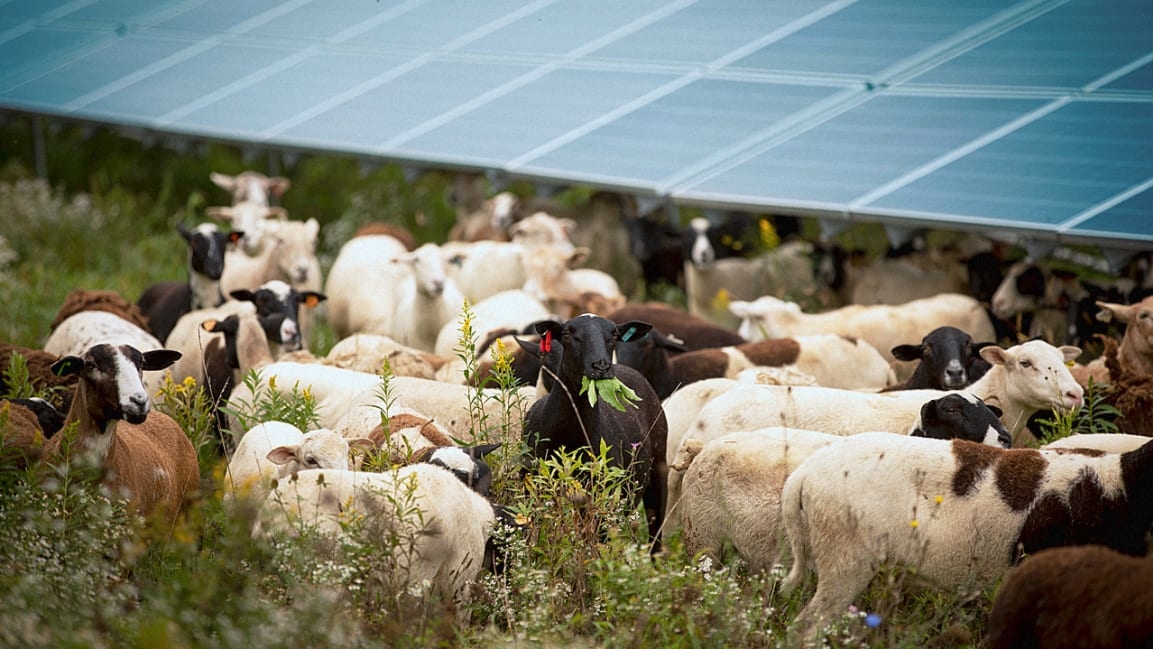When these solar farms need their grass cut, they call in some woolly landscapers
On some solar farms in New York state, sheep act as landscapers, grazing among the solar panels to manage vegetation. It’s a way to manage industrial-scale solar arrays without the use of fossil fuel-powered equipment like lawn mowers, and it provides an opportunity for local farmers to earn money contracting out their sheep. It could also spur the creation of a business cooperative to coordinate between shepherds and solar companies.
Ramping up renewable energy means setting aside more and more land for solar arrays, and often it’s agricultural land that gets transferred to solar production. To some, this expansion seems like a loss of farmland, but to others, it’s a new opportunity for farmers. “The developers need to maintain the land, and to me it seems a little ironic we’re developing land for renewable energy and then, because you have to manage that vegetable growth to keep it from shading the panels, to bring in mowers that run on fossil fuels, or to spray herbicide to control that,” says Todd Schmit, an associate professor at Cornell University who focuses on agricultural economics and cooperatives, and lead of a new project (in partnership with the Department of Agriculture) that is exploring the economic benefits that could come from partnering farmers and solar providers. “There’s another opportunity that supports both reducing greenhouse gas emissions and using fuels while also benefiting agriculture.”

There’s also an opportunity not just for farmers to make money by contracting out their sheep to graze solar arrays, but to reduce our reliance on imported lamb. Americans eat less lamb per capita than other countries, but more than half of the meat that is eaten here is imported from Australia and New Zealand. “Here’s an opportunity to sort of reduce reliance on imports if we can actually expand domestic production,” Schmit says, and that also means there could be new marketing opportunities, like creating a label for “solar-grazed sheep.”
But before farmers can find those economic or marketing opportunities, they have to start negotiating logistics with the large solar companies in charge of those arrays. Cornell has already done research looking at how solar grazing saves greenhouse gas emissions and the opportunities and benefits of solar-grazing partnerships. But a sheep-farmer friend of Schmit explained to him some of the challenges of the system.
For individual farmers, coordinating with large, multinational industrial solar companies can be daunting. “As we were having this conversation, I said, ‘sounds like you need a co-op,’” he says. Co-ops, or cooperatives, are member-owned organizations that work to meet common economic (and in some cases social) needs. Rather than individual farmers going through grazing negotiations or figuring out logistics related to transportation, timing, insurance, and all the infrastructure needs for getting their sheep to the solar arrays on their own, those details could be solved collectively, benefiting all the farmers in the region who want to forge such partnerships.
The Cornell and USDA project (which will also collaborate with the American Solar Grazing Association) is a three-year, $500,000 venture into how to scale these solar-grazing opportunities through a farmer-owned organization, and then, depending on the interests of the farmers involved, what marketing opportunities could come from expanding sheep livestock in this way. Based on the energy goals of New York State alone, Schmit says, “there aren’t enough sheep in the state of New York to graze all those acres” of solar arrays, so there’s a chance not only for current sheep farmers to make more money but for new farmers to enter this space.
The project will focus on the northeast, with farmers in New York, Pennsylvania, and New England states, and begin with what Schmit calls “co-ops development 101,” including talking with prospective members, figuring out their needs and desires from such an organization, and nailing down a collective vision for this kind of business. From there it might shift to working on contract negotiations with solar developers or collectively buying equipment in a way that is more cost efficient, or then figuring out the market for this livestock and even building their own processing plant.
Though this project is focused on the northeast, Schmit hopes it can become a guide for sheep farmers across the country, so they can form their own regional co-ops without having to start from scratch. Those co-ops may be different—the average sheep farm in Colorado looks different than one in New York—but they could look to the models and bylaws that this project figures out, and part of the funding from the USDA will go toward developing those kind of tools, for financial analysis or just the process of starting a co-op, that others can use.
Fast Company , Read Full Story
(43)



